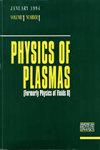形成 β > 1 的圆柱形等离子体平衡态
IF 2.2
3区 物理与天体物理
Q3 PHYSICS, FLUIDS & PLASMAS
引用次数: 0
摘要
从行星磁层、太阳黑子、磁洞到核聚变实验室实验,许多物理系统都实现了高贝塔等离子体平衡。当等离子体压力大到足以将磁场从其体积中完全排出时,粒子轨迹就不能再被视为圆形陀螺轨道,等离子体压力也不再是陀螺效应。这些非陀螺效应需要动力学描述,并在磁重联问题中被积极研究了很长时间。在本文中,我们将证明等离子体压力的非回转性使得有限尺寸等离子体有可能明显超过磁流体力学所规定的极限β=1,这对某些聚变方案(如镜面和尖顶配置)可能具有吸引力。作为第一步,我们研究了这些效应如何在一个简单的经典问题中表现出来,即用均匀的真空磁场约束一个圆柱形等离子体柱。通过粒子入胞模拟,我们发现内部磁场为零的二磁泡型平衡是由电子产生的亚离子尺度的电流层形成的,并发现中心等离子体的气体动压超过真空磁场压力的 15%。本文章由计算机程序翻译,如有差异,请以英文原文为准。
Formation of cylindrical plasma equilibria with β > 1
High-beta plasma equilibria are realized in a number of physical systems, from planetary magnetospheres, sunspots, and magnetic holes to fusion laboratory experiments. When plasma pressure becomes large enough to completely expel the magnetic field from its volume, the particle trajectories cannot be considered any more as circular gyro-orbits, and plasma pressure ceases to be gyrotropic. These non-gyrotropic effects require kinetic description and are actively studied for a long time in the magnetic reconnection problem. In this paper, we will show that non-gyrotropy of plasma pressure makes it possible to markedly exceed the limit β=1 dictated by the magnetohydrodynamics for finite-size plasmas, which may be attractive for some fusion schemes such as mirror and cusp configurations. As a first step, we study how these effects manifest themselves in a simple classical problem of confining a cylindrical plasma column by a uniform vacuum magnetic field. Using particle-in-cell simulations, we show that the equilibrium of the diamagnetic bubble type with zero internal magnetic field is formed with an electron-produced current layer of sub-ion scale and found that the gas-kinetic pressure of the central plasma exceeds the pressure of the vacuum magnetic field by 15%.
求助全文
通过发布文献求助,成功后即可免费获取论文全文。
去求助
来源期刊

Physics of Plasmas
物理-物理:流体与等离子体
CiteScore
4.10
自引率
22.70%
发文量
653
审稿时长
2.5 months
期刊介绍:
Physics of Plasmas (PoP), published by AIP Publishing in cooperation with the APS Division of Plasma Physics, is committed to the publication of original research in all areas of experimental and theoretical plasma physics. PoP publishes comprehensive and in-depth review manuscripts covering important areas of study and Special Topics highlighting new and cutting-edge developments in plasma physics. Every year a special issue publishes the invited and review papers from the most recent meeting of the APS Division of Plasma Physics. PoP covers a broad range of important research in this dynamic field, including:
-Basic plasma phenomena, waves, instabilities
-Nonlinear phenomena, turbulence, transport
-Magnetically confined plasmas, heating, confinement
-Inertially confined plasmas, high-energy density plasma science, warm dense matter
-Ionospheric, solar-system, and astrophysical plasmas
-Lasers, particle beams, accelerators, radiation generation
-Radiation emission, absorption, and transport
-Low-temperature plasmas, plasma applications, plasma sources, sheaths
-Dusty plasmas
 求助内容:
求助内容: 应助结果提醒方式:
应助结果提醒方式:


